5 How Computers Calculate - the ALU
5 算术逻辑单元
Hi, I'm Carrie Ann and this is Crash Course Computer Science.
嗨,我是CarrieAnne,欢迎收看计算机科学速成课
So last episode, we talked about how numbers can be represented in binary.
上集,我们谈了如何用二进制表示数字
Representing Like, 00101010 is 42 in decimal.
比如二进制00101010是十进制的42
Representing and storing numbers is an important function of a computer,
表示和存储数字是计算机的重要功能
but the real goal is computation, or manipulating numbers in a structured and purposeful way,
但真正的目标是计算,有意义的处理数字
like adding two numbers together.
比如把两个数字相加
These operations are handled by a computer's Arithmetic and Logic Unit,
这些操作由计算机的"算术逻辑单元"处理
but most people call it by its street name:
但大家会简称:
the ALU.
ALU
The ALU is the mathematical brain of a computer.
ALU是计算机的数学大脑
When you understand an ALU's design and function,
等你理解了ALU的设计和功能之后
you'll understand a fundamental part of modern computers.
你就理解了现代计算机的基石
It is THE thing that does all of the computation in a computer,
ALU就是计算机里负责运算的组件,
so basically everything uses it.
基本其他所有部件都用到了它
First though, look at this beauty.
先来看看这个美人
This is perhaps the most famous ALU ever, the Intel 74181.
这可能是最著名的ALU,英特尔74181
When it was released in 1970,
1970年发布时,
it was It was the first complete ALU that fit entirely inside of a single chip -
它是第一个封装在单个芯片内的完整ALU
Which was a huge engineering feat at the time.
这在当时是惊人的工程壮举
So today we're going to take those Boolean logic gates we learned about last week
今天我们用上周学的布尔逻辑门
to build a simple ALU circuit with much of the same functionality as the 74181.
做一个简单的ALU电路,功能和74181一样
And over the next few episodes we'll use this to construct a computer from scratch.
然后接下来几集,用它从头做出一台电脑
So it's going to get a little bit complicated,
所以会有点复杂
but I think you guys can handle it.
但我觉得你们搞的定
An ALU is really two units in one
ALU有2个单元,
there's an arithmetic unit and a logic unit.
1个算术单元和1个逻辑单元
Let's start with the arithmetic unit,
我们先讲"算术单元",
which is responsible for handling all numerical operations in a computer,
它负责计算机里的所有数字操作
like addition and subtraction.
比如加减法
It also does a bunch of other simple things like add one to a number,
它还做很多其他事情,比如给某个数字+1
which is called an increment operation, but we'll talk about those later.
这叫增量运算,我们之后会说
Today, we're going to focus on the piece of rsistance, the crme de la crme of operations
今天的重点是一切的根本
that underlies almost everything else a computer does adding two numbers together.
"把两个数字相加"
We could build this circuit entirely out of individual transistors,
我们可以用单个晶体管一个个拼,把这个电路做出来,
but that would get confusing really fast.
但很快就会复杂的难以理解
So instead as we talked about in Episode 3
所以与其用晶体管,我们会像第3集
we can use a high-level of abstraction and build our components out of logic gates,
用更高层的抽象,用逻辑门来做
in this case: AND, OR, NOT and XOR gates.
我们会用到AND,OR,NOT和XOR逻辑门
The simplest adding circuit that we can build takes two binary digits, and adds them together.
最简单的加法电路,是拿2个bit加在一起(bit是0或1)
So we have two inputs, A and B, and one output, which is the sum of those two digits.
有2个输入:A和B,1个输出:就是两个数字的和
Just to clarify: A, B and the output are all single bits.
需要注意的是:A,B,输出,这3个都是单个Bit(0或1)
There are only four possible input combinations.
输入只有四种可能
The first three are: 0+0 = 0
前三个是,0+0=0
1+0 = 1 0+1 = 1
1+0=1,0+1=1
Remember that in binary, 1 is the same as true, and 0 is the same as false.
记住二进制里,1与true相同,0与false相同
So this set of inputs exactly matches the boolean logic of an XOR gate,
这组输入和输出,和XOR门的逻辑完全一样
and we can use it as our 1-bit adder.
所以我们可以把XOR用作1位加法器(adder)
But the fourth input combination, 1 + 1, is a special case. 1 + 1 is 2 (obviously)
但第四个输入组合,1+1,是个特例,1+1=2(显然)
but there's no 2 digit in binary,
但二进制里没有2
so as we talked about last episode, the result is 0 and the 1 is carried to the next column.
上集说过,二进制1+1的结果是0,1进到下一位
So the sum is really 10 in binary.
和是10(二进制)
Now, the output of our XOR gate is partially correct 1 plus 1, outputs 0.
XOR门的输出,只对了一部分,1+1输出0
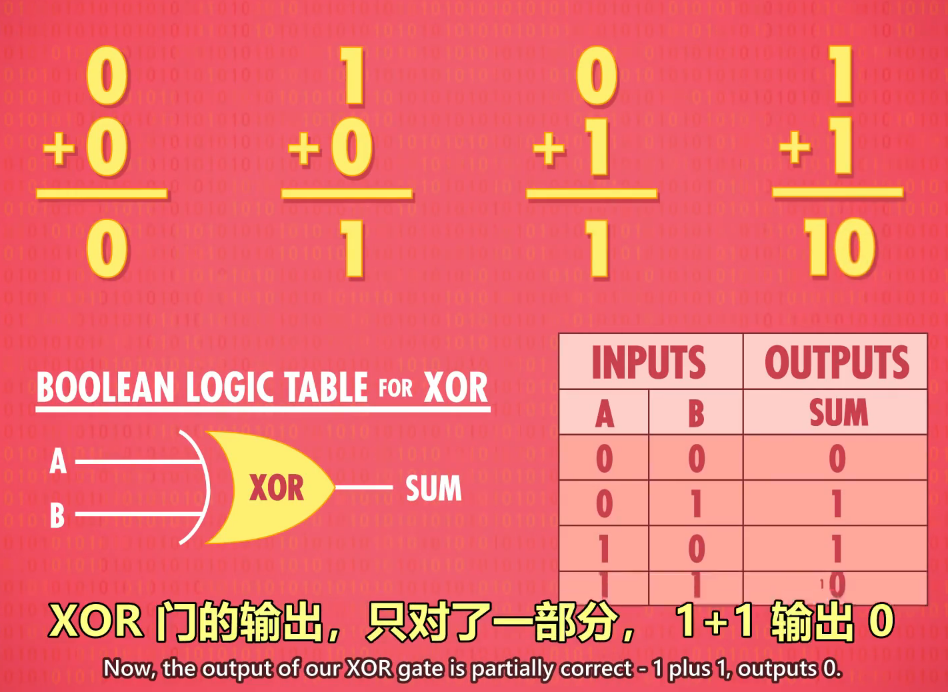
But, we need an extra output wire for that carry bit.
但我们需要一根额外的线代表"进位"
The carry bit is only "true" when the inputs are 1 AND 1,
只有输入是1和1时,进位才是"true"
because that's the only time when the result (two) is bigger than 1 bit can store
因为算出来的结果用1个bit存不下
and conveniently we have a gate for that!
方便的是,我们刚好有个逻辑门能做这个事!
It's not that complicated just two logic gates -
没那么复杂就两个逻辑门而已
but let's abstract away even this level of detail
让我们抽象化
and encapsulate our newly minted half adder as its own component,
把"半加器"封装成一个单独组件
with two inputs bits A and B and two outputs, the sum and the carry bits.
两个输入A和B都是1位,两个输出"总和"与"进位"
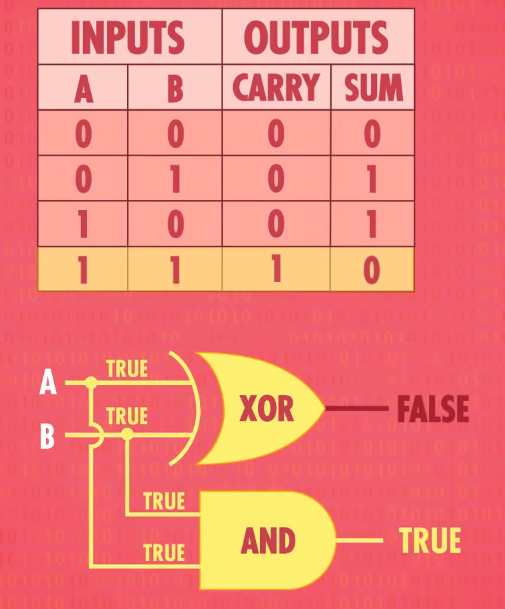
This takes us to another level of abstraction
这进入了另一层抽象
heh I feel like I say that a lot.
我好像说了很多次,
I wonder if this is going to become a thing.
说不定会变成一个梗
Anyway, If you want to add more than 1 + 1
如果想处理超过1+1的运算,
we're going to need a "Full Adder."
如我们需要"全加器"
That half-adder left us with a carry bit as output.
半加器输出了进位
That means that when we move on to the next column in a multi-column addition,
意味着,我们算下一列的时候
and every column after that, we are going to have to add three bits together, no two.
还有之后的每一列,我们得加3个位在一起,并不是2个
A full adder is a bit more complicated
全加器复杂了一点点
it takes three bits as inputs: A, B and C.
有3个输入:A,B,C(都是1个bit)
So the maximum possible input is 1 + 1 + 1,
所以最大的可能是1+1+1
which equals 1 carry out 1, so we still only need two output wires: sum and carry.
总和1"进位"1,所以要两条输出线:"总和"和"进位"
We can build a full adder using half adders.
我们可以用半加器做全加器
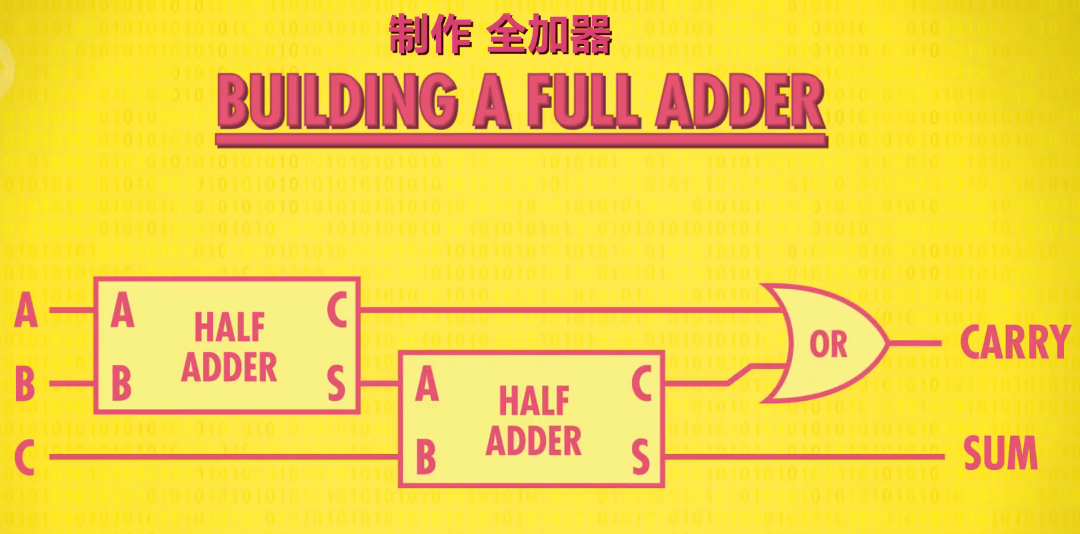
To do this, we use a half adder to add A plus B
我们先用半加器将A和B相加
just like before but then feed that result and input C into a second half adder.
然后把C输入到第二个半加器
Lastly, we need a OR gate to check if either one of the carry bits was true.
最后用一个OR门检查进位是不是true
That's it, we just made a full adder!
这样就做出了一个全加器!
Again,we can go up a level of abstraction and wrap up this full adder as its own component.
我们可以再提升一层抽象,把全加器作为独立组件
It takes three inputs, adds them, and outputs the sum and the carry, if there is one.
全加器会把A,B,C三个输入加起来,输出"总和"和"进位"
Armed with our new components, we can now build a circuit that takes two, 8-bit numbers
现在有了新组件,我们可以相加两个8位数字
Let's call them A and B and adds them together.
叫两个数字叫A和B好了
Let's start with the very first bit of A and B,
我们从A和B的第一位开始
which we'll call A0 and B0.
叫A0和B0好了
At this point, there is no carry bit to deal with,
现在不用处理任何进位,
because this is our first addition.
因为是第一次加法
So we can use our half adder to add these two bits together.
所以我们可以用半加器,来加这2个数字
The output is sum0.
输出叫sum0
Now we want to add A1 and B1 together.
现在加A1和B1
It's possible there was a carry from the previous addition of A0 and B0,
因为A0和B0的结果有可能进位
so this time we need to use a full adder that also inputs the carry bit.
所以这次要用全加器,除了A1和B1,还要连上进位
We output this result as sum1.
输出叫sum1
Then, we take any carry from this full adder,
然后,把这个全加器的进位,连到下个全加器的输入,处理A2和B2
and run it into the next full adder that handles A2 and B2.
然后,把这个全加器的进位,连到下个全加器的输入,处理A2和B2
And we just keep doing this in a big chain until all 8 bits have been added.
以此类推,把8个bit都搞定
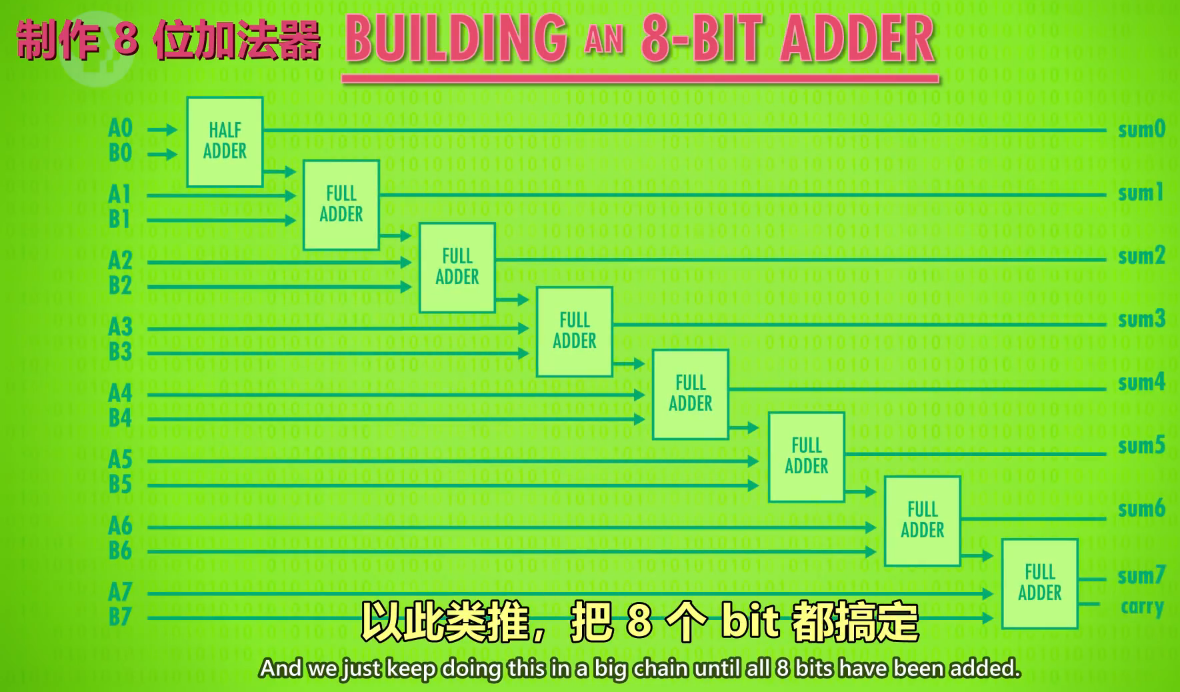
Notice how the carry bits ripple forward to each subsequent adder.
注意每个进位是怎么连到下一个全加器的
For this reason, this is called an 8-bit ripple carry adder.
所以叫"8位行波进位加法器"
Notice how our last full adder has a carry out.
注意最后一个全加器有"进位"的输出
If there is a carry into the 9th bit, it means the sum of the two numbers is too large to fit into 8-bits.
如果第9位有进位,代表着2个数字的和太大了,超过了8位
This is called an overflow.
这叫"溢出"(overflow)
In general, an overflow occurs when the result of an addition is too large
一般来说"溢出"的意思是,两个数字的和太大了
to be represented by the number of bits you are using.
超过了用来表示的位数
This can usually cause errors and unexpected behavior.
这会导致错误和不可预期的结果
Famously, the original PacMan arcade game used 8 bits to keep track of what level you were on.
著名的例子是,吃豆人用8位存当前关卡数
This meant that if you made it past level 255 the largest number storablein 8 bits to level 256,
如果你玩到了第256关(8位bit最大表示255)
the ALU overflowed.
ALU会溢出
This caused a bunch of errors and glitches making the level unbeatable.
造成一连串错误和乱码,使得该关卡无法进行
The bug became a rite of passage for the greatest PacMan players.
这个bug成了厉害吃豆人玩家的代表
So if we want to avoid overflows,
如果想避免溢出
we can extend our circuit with more full adders, allowing us to add 16 or 32 bit numbers.
我们可以加更多全加器,可以操作16或32位数字
This makes overflows less likely to happen, but at the expense of more gates.
让溢出更难发生,但代价是更多逻辑门
An additional downside is that it takes a little bit of time for each of the carries to ripple forward.
另外一个缺点是,每次进位都要一点时间
Admittedly, not very much time, electrons move pretty fast,
当然时间不久,因为电子移动的很快
so we're talking about billionths of a second,
但如今的量级是每秒几十亿次运算,
but that's enough to make a difference in today's fast computers.
所以会造成影响
For this reason, modern computers use a slightly different adding circuit
所以,现代计算机用的加法电路有点不同
called a 'carry-look-ahead' adder
叫"超前进位加法器"
which is faster, but ultimately does exactly the same thing
它更快,做的事情是一样的
adds binary numbers.
把二进制数相加
The ALU's arithmetic unit also has circuits for other math operations
ALU的算术单元,也能做一些其他数学运算
and in general these 8 operations are always supported.
一般支持这8个操作
And like our adder, these other operations are built from individual logic gates.
就像加法器一样,这些操作也是由逻辑门构成的
Interestingly, you may have noticed that there are no multiply and divide operations.
有趣的是,你可能注意到没有乘法和除法
That's because simple ALUs don't have a circuit for this,
因为简单的ALU没有专门的电路来处理
and instead just perform a series of additions.
而是把乘法用多次加法来实现
Let's say you want to multiply 12 by 5.
假设想算12x5
That's the same thing as adding 12 to itself 5 times.
这和把"12"加5次是一样的
So it would take 5 passes through the ALU to do this one multiplication.
所以要5次ALU操作来实现这个乘法
And this is how many simple processors,
很多简单处理器都是这样做的
like those in your thermostat, TV remote, and microwave, do multiplication.
比如恒温器,电视遥控器和微波炉
It's slow, but it gets the job done.
慢是慢,但是搞的定
However, fancier processors, like those in your laptop or smartphone,
然而笔记本和手机有更好的处理器
have arithmetic units with dedicated circuits for multiplication.
有专门做乘法的算术单元
And as you might expect, the circuit is more complicated than addition
你可能猜到了,乘法电路比加法复杂
there's no magic, it just takes a lot more logic gates
没什么魔法,只是更多逻辑门
which is why less expensive processors don't have this feature.
所以便宜的处理器没有.
Ok, let's move on to the other half of the ALU:
好了,我们现在讲ALU的另一半:
the Logic Unit.
逻辑单元
Instead of arithmetic operations, the Logic Unit performs well...
逻辑单元执行逻辑操作
logical operations, like AND, OR and NOT, which we've talked about previously.
比如之前讨论过的AND,OR和NOT操作
It also performs simple numerical tests,
它也能做简单的数值测试
like checking if a number is negative.
比如一个数字是不是负数
For example, here's a circuit that tests if the output of the ALU is zero.
例如,这是检查ALU输出是否为0的电路
It does this using a bunch of OR gates to see if any of the bits are 1.
它用一堆OR门检查其中一位是否为1
Even if one single bit is 1,
哪怕只有一个Bit(位)是1,
we know the number can't be zero and then we use a final NOT gate to flip this input
我们就知道那个数字肯定不是0,然后用一个NOT门取反
so the output is 1 only if the input number is 0.
所以只有输入的数字是0,输出才为1
So that's a high level overview of what makes up an ALU.
以上就是ALU的一个高层次概括
We even built several of the main components from scratch, like our ripple adder.
我们甚至从零做了几个主要组件,比如行波进位加法器
As you saw, it's just a big bunch of logic gates connected in clever ways.
它们只是一大堆逻辑门巧妙的连在一起而已.
Which brings us back to that ALU you admired so much at the beginning of the episode.
让我们回到视频开始时的ALU,
The Intel 74181.
英特尔74181
Unlike the 8-bit ALU we made today, the 74181 could only handle 4-bit inputs,
和我们刚刚做的8位ALU不同,74181只能处理4位输入
which means
也就是说
YOU BUILT AN ALU THAT'S LIKE TWICE AS GOOD AS THAT SUPER FAMOUS ONE. WITH YOUR MIND!
你刚做了一个比英特尔74181还好的ALU!
Well.. sort of.
其实差不多啦..
We didn't build the whole thing
我们虽然没有全部造出来
but you get the idea.
但你理解了整体概念
The 74181 used about 70 logic gates, and it couldn't multiply or divide.
74181用了大概70个逻辑门,但不能执行乘除.
But it was a huge step forward in miniaturization,
但它向小型化迈出了一大步
opening the doors to more capable and less expensive computers.
让计算机可以更强大更便宜
This 4-bit ALU circuit is already a lot to take in,
4位ALU已经要很多逻辑门了
but our 8-bit ALU would require hundreds of logic gates to fully build
但我们的8位ALU会需要数百个逻辑门
and engineers don't want to see all that complexity when using an ALU,
工程师不想在用ALU时去想那些事情,
so they came up with a special symbol to wrap it all up, which looks like a big V'.
所以想了一个特殊符号来代表它,看起来像一个大"V"
Just another level of abstraction!
又一层抽象!
Our 8-bit ALU has two inputs, A and B, each with 8 bits.
我们的8位ALU有两个输入,A和B,都是8位(bits)
We also need a way to specify what operation the ALU should perform,
我们还需要告诉ALU执行什么操作
for example, addition or subtraction.
例如加法或减法
For that, we use a 4-bit operation code.
所以我们用4位的操作代码
We'll talk about this more in a later episode,
我们之后的视频会再细说
but in brief, 1000 might be the command to add, while 1100 is the command for subtract.
简言之,"1000"可能代表加法命令,"1100"代表减法命令
Basically, the operation code tells the ALU what operation to perform.
操作代码告诉ALU执行什么操作
And the result of that operation on inputs A and B is an 8-bit output.
输出结果是8位的
ALUs also output a series of Flags,
ALU还会输出一堆标志(Flag)
which are 1-bit outputs for particular states and statuses.
标志是1位的,代表特定状态.
For example, if we subtract two numbers, and the result is 0,
比如相减两个数字,结果为0
our zero-testing circuit, the one we made earlier, sets the Zero Flag to True (1).
我们的零测试电路(前面做的),会将零标志设为True(1)
This is useful if we are trying to determine if two numbers are are equal.
如果想知道两个数字是否相等,这个非常有用

If we wanted to test if A was less than B,
如果想知道:A是否小于B
we can use the ALU to calculate A subtract B and look to see if the Negative Flag was set to true.
可以用ALU来算A减B,看负标志是否为true
If it was, we know that A was smaller than B.
如果是true,我们就知道A小于B
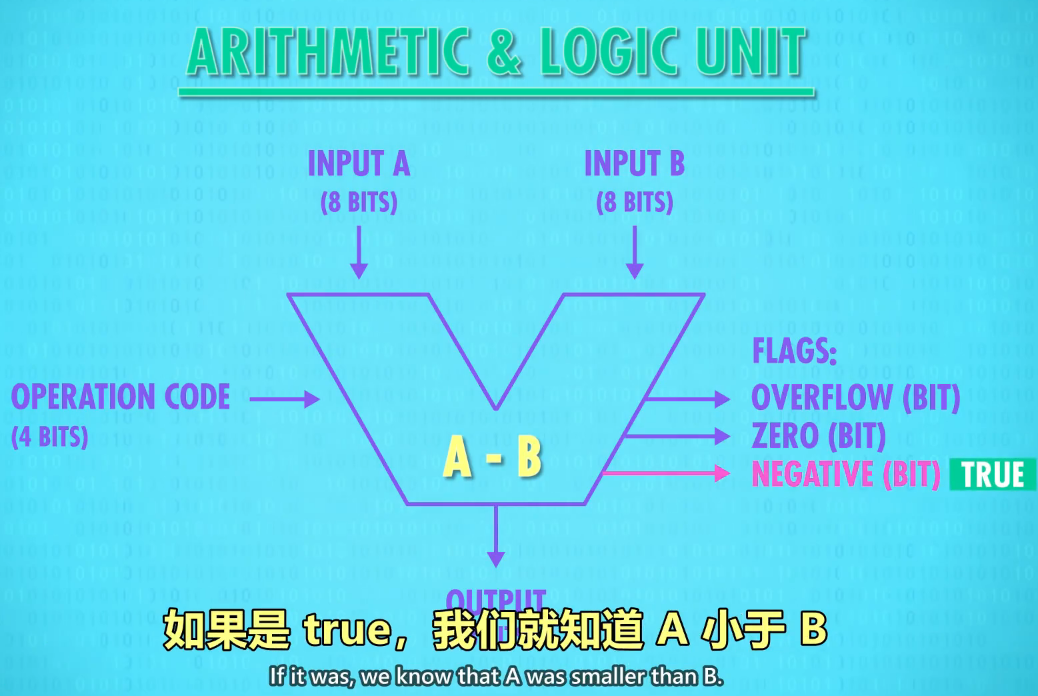
And finally, there's also a wire attached to the carry out on the adder we built,
最后,还有一条线连到加法器的进位
so if there is an overflow, we'll know about it.
如果有溢出,我们就知道
This is called the Overflow Flag.
这叫溢出标志
Fancier ALUs will have more flags,
高级ALU有更多标志
but these three flags are universal and frequently used.
但这3个标志是ALU普遍用的
In fact, we'll be using them soon in a future episode.
其实,我们之后的视频会用到它们
So now you know how your computer does all its basic mathematical operations digitally
现在你知道了,
with no gears or levers required.
计算机是怎样在没有齿轮或杠杆的情况下进行运算
We're going to use this ALU when we construct our CPU two episodes from now.
接下来两集我们会用ALU做CPU
But before that, our computer is going to need some memory!
但在此之前,计算机需要一些"记忆"!
We'll talk about that next week.
我们下周会讲